The original URL of this article is:
www.africaspeaks.com/kenya/19082006b.html
My First Week in Kenya
by Akilah Stewart
August 19, 2006
UWI Students Trip to Kenya
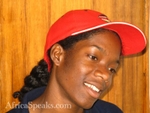 | | | Akilah Stewart | |
On the 8th June, 2006 I was one of eighteen students from the University of the West Indies to depart from Trinidad for a Student Exchange in Kenya. That day was a very extraordinary one especially for those, myself included, who had been on the Steering Committee for the Trip. The earliest date associated with this trip and its preparation was 23rd January 2006 which was when the Ministry of Public Utilities and the Environment received a letter from the head of the Kenya Volunteer Development Services (KVDS), a non-governmental organization based in Bungoma, Kenya extending an invitation for any Universities, Environmental Clubs and humanitarian groups to make links with them. This letter was forwarded to the University of the West Indies, St. Augustine Campus and was subsequently forwarded to the UWI Guild. During the hectic pre-exam time of April, throughout all of May and even mere hours before our departure time on the 8th June, meticulous and arduous preparation took place to make the trip a resounding success that it would eventually turn out to be.
Our travel to Kenya took three days. The first leg of travel involved taking the first sailing of the fast ferry to Tobago in the morning. Of all the occasions for the boat to be late, by a near three hours, that Thursday happened to be the day! This we were informed was associated with some petrol-related issue. That event, like quite a few leading up to that date, emphasized the importance of not taking any detail whatsoever for granted. For it was immediately appreciated by the delegation that if our flight to England was scheduled earlier than the 6:00pm check-in time we would have been in danger of not going any where at all. In Tobago we took a flight to England, arriving in England on Friday and from England we flew to The United Arab Emirates. On departing from the United Arab Emirates it took 5 weary hours on the plane to reach to the Jomo Kenyatta Airport, in Nairobi, Kenya. After a total of 21 hours of flying we arrived in Kenya around 1:00pm local time on Saturday 10th June 2006.
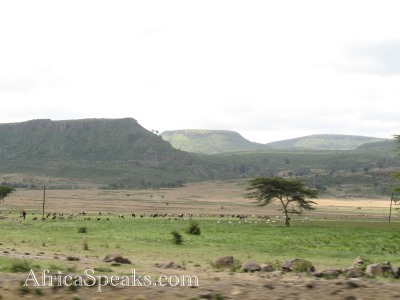 | | Plateaued mountain tops with savannah foreground |
Tired, disoriented and anxious we approached an entrance of the Airport where we were received by our host Mr. Malaho. A wide and refreshing smile along with individual hugs which he dispatched to complete strangers from half way around the world, was his way of greeting us. After a brief introduction we were taken to the Ambassadeur Hotel in Nairobi where we were to overnight. One of the first memories of being in Kenya, in fact, in Africa was the smooth, cool feel of the air. It was about 20 degrees Celsius in Nairobi on that day. At the hotel we had a view of the city being six and seven floors above ground level. The view was an impressive one of a building filled skyline and what struck us then and right throughout the trip was the number of people coming and going from all directions, a site that would be observed not only in the city but in the towns and villages.
On Sunday we left Nairobi for Bungoma Town, which is located in the Western Province of Kenya. The journey took approximately eight hours. There is so much that can be mentioned about this drive of all drives. We passed idyllic postcard finished looking lakes, acacia dominated savannahs where zebras grazed, mountains with archaic looking weathered and plateaued stone tops and we even crossed the equator on our way to Bungoma! We made a sightseeing stop at the Great Rift Valley; this expanse of land was, in dramatic fashion, beyond large. We had our first taste of their peas-less pelau called pilau and were thrust rather abruptly into the world of Swahili when it came to making our orders. One can write paragraphs upon paragraphs to describe the host of things that were part of this second day of our Kenyan experience. Late Sunday with the very long day trip behind us, we arrived at the Mabanga Farmers' Training Centre in Bungoma where we would spend the next week.
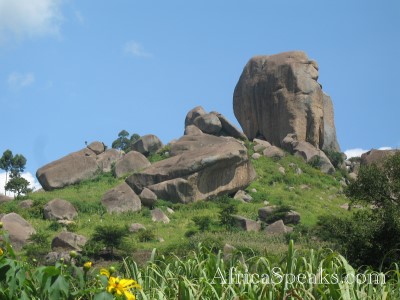 | | One of the Rock Parks we visited - Mwibale Rock Hill |
After all the traveling, Monday the 12th was a welcomed rest day. We went to Bungoma town by matatu, their version of a maxi taxi, to visit the Bank, internet café and Grocery. I cannot say that I was ever threatened or uncomfortable in Bungoma town. For the most part we fit into the whole scheme of things as we did our activities. Of course our accents, behaviour and difference in dress drew attention to us from locals in our immediate environment. The women wore more skirts and more loose fitting clothes and as I think of it now, not a lot of jeans clothing that we as University students have a preference for. That night four of the delegates came down with bouts of diarrhea and vomiting, it was the first of many instances where, while adjusting to the difference in food and water, members of the delegation would become sick.
Tuesday was the day we went to Uganda to experience crossing over the border and to shop a little. At the border between Uganda and Kenya we crossed a river and a small stretch of land called 'No Man's Land', so named because it is not owned by either country. Being a newcomer to the place, it seemed that just the way it is said sometimes that all Chinese people look the same, you saw one Kenyan face and you saw all. It was pointed out to me that day by our guide Esther Malaho, Mr Malaho's daughter, that there are over 40 tribes in Kenya and on taking more informed looks, some of the tribal differences of the one or two she had described became evident. Later that day we went to two Rock Parks. The Geology of Bungoma is intriguing. The land seems so old, so weathered. Stones that appear to have been deliberately scattered litter, quite literally, a lot of the hillside. So countless they numbered that corn fields being planted around these sometimes car and house-sized boulders was all too common a site.
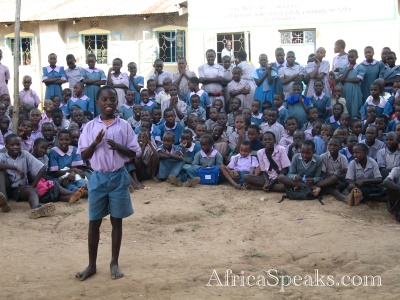 | | Students of the Sio R. C. Primary School look at HIV/AIDS skit |
On Wednesday we went on our first school visit to the Sio R. C. Primary School. Here we were introduced, for the first time publicly to Kenyans. The principal and staff welcomed us by giving us a tour of their school. I admit that I was disheartened at the infrastructure on the compound. It is safe to say that no school in Trinidad is at the level of what we saw. There were no lights in the principal's office and no ceiling just the roof. One of their toilets, called long drops which are essentially latrines had caved in because the soil type did not support such a cavity in the ground. But such scenes were thrown into second focus when we were greeted by the students who performed for us. Their excitement, energy and pure light captivated us. They presented skits on HIV/AIDS and Rape awareness, baffling us about the level of their understanding of such sensitive social issues at ages under 12 years and at extreme upper ages of 13 and 14. Later that day we were taken to the spectacular Webuye Waterfalls where there is a tree that was planted by the first President of Kenya, Jomo Kenyatta.
We were given a tour of one of the KDVS Agroforestry Stations on Thursday morning. The amount of activity here reflects the amount of years, over ten that it has been in operation. Mr. Malaho described how his organiztion had transformed this characteristically flooded area using Eucalyptus which draws large amounts of water from the soil it is planted in. He gave an in depth description of agricultural and forestry practices and information as well as botanical data to the benefit of the Natural Sciences students. Following this were visits to two schools in the afternoon. I was only able to attend the first school out reach at Lunao Primary School. We were accompanied by a government Minister who was also part of the morning tour to the school where we were part of a very formal tree planting ceremony which coupled as a celebratory event for the recent opening of this school. Again we were introduced to the school population, teachers and other staff as well as PTA representatives. Then some male students performed what can only be described as a musical piece that was just shy of chilling, so moved were we by there execution of it. Equally well received by us was a dance piece performed by a handful of female students. The second school that was visited that day was Sunrise Academy.
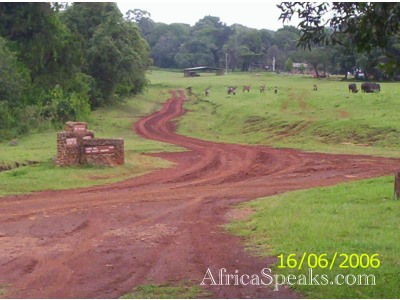 | | Kitale Road on the way back from Mt. Elgon |
Mt. Elgon is the second largest extinct volcano in Kenya and the fact that the forest around its base is pristine has resulted in it sustaining a diverse wildlife population. Among the well heard of animals there are the underground elephants. We traveled here to a wildlife reserve to go on a safari, which is Kisawahili for journey. Unfortunately circumstances prevented us from actually being able to. The drive was characteristically long but shockingly dusty. It happens that the countryside is always very green but the unpaved roads of this area are a fascinating red-brown. When dry the dust is very light and when caught in the air it borders on a health concern for the likes of newcomers such as us. Unfortunately circumstances prevented us from actually being able to enter the park. This was a great disappointment. Interestingly enough, the both matatus that were driving us to all the places we were scheduled to visit were stopped and charged for cracked windshields which only added to a feeling of dismay that pervaded this day. We had lunch of fried chicken, chips and purple onion salad in the town of Kitale which is south east of Mt. Elgon. Later that day we were to go to an Agroforestry Centre and a Museum also located in Kitale but we arrived too late so we were unable to enter.
Finally on Saturday we partook in a cultural exchange where we were exposed to some rather energetic and awesome display of dance by some local girls. We put on a small performance which included music indigenous to our country with the accompaniment of the pan, to the delight of the scores of children who had come. There was also a football match which we lost and perhaps quite rightly because when the game ended in a draw, there were penalty kicks and when the first five possible choices were exhausted there was another round, followed by the captains and even our lone female member pitched in with her shot. They scored the penalty kick that mattered most in the end. Nevertheless, it marked the conclusion of a very memorable and intense first week but was hardly an indicator of what was yet to come.
UWI Students Trip to Kenya in pictures:
http://rastafarispeaks.com/gallery/Trip_to_Africa_2006
|
|